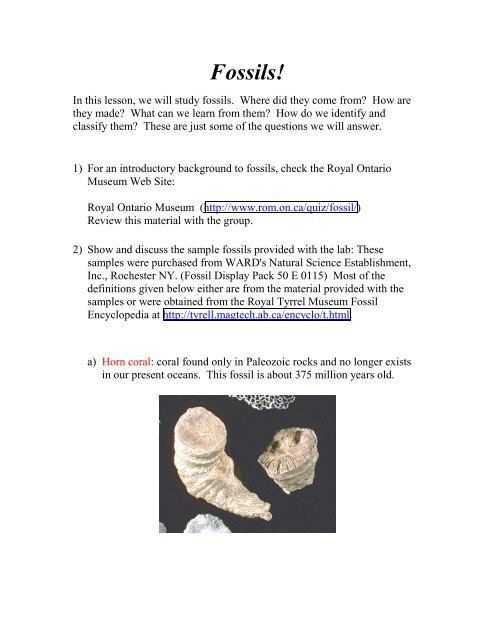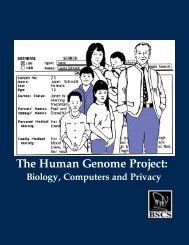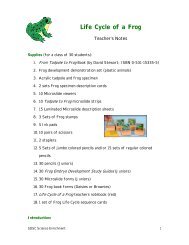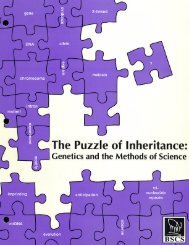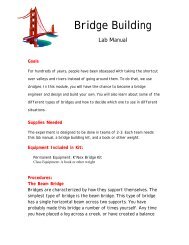Print the Fossils activity worksheets. - SDSC Education
Print the Fossils activity worksheets. - SDSC Education
Print the Fossils activity worksheets. - SDSC Education
You also want an ePaper? Increase the reach of your titles
YUMPU automatically turns print PDFs into web optimized ePapers that Google loves.
<strong>Fossils</strong>!<br />
In this lesson, we will study fossils. Where did <strong>the</strong>y come from? How are<br />
<strong>the</strong>y made? What can we learn from <strong>the</strong>m? How do we identify and<br />
classify <strong>the</strong>m? These are just some of <strong>the</strong> questions we will answer.<br />
1) For an introductory background to fossils, check <strong>the</strong> Royal Ontario<br />
Museum Web Site:<br />
Royal Ontario Museum (http://www.rom.on.ca/quiz/fossil/)<br />
Review this material with <strong>the</strong> group.<br />
2) Show and discuss <strong>the</strong> sample fossils provided with <strong>the</strong> lab: These<br />
samples were purchased from WARD's Natural Science Establishment,<br />
Inc., Rochester NY. (Fossil Display Pack 50 E 0115) Most of <strong>the</strong><br />
definitions given below ei<strong>the</strong>r are from <strong>the</strong> material provided with <strong>the</strong><br />
samples or were obtained from <strong>the</strong> Royal Tyrrel Museum Fossil<br />
Encyclopedia at http://tyrell.magtech.ab.ca/encyclo/t.html.<br />
a) Horn coral: coral found only in Paleozoic rocks and no longer exists<br />
in our present oceans. This fossil is about 375 million years old.
) Bryozoan ("moss animals"): small aquatic animals. They average less<br />
than 1 millimeter in length but live in large colonies that are as much<br />
as 30 cm across. This is approximately 12 inches -- <strong>the</strong> length of a<br />
standard ruler. Modern bryozoans are found in warm shallow seas,<br />
where <strong>the</strong>y grow attached to <strong>the</strong> sea floor.<br />
c) Brachiopod ("lamp shells"): brachiopods are a common type of<br />
shellfish found in marine rocks from early in <strong>the</strong> Cambrian period<br />
onwards, and <strong>the</strong>y have survived to <strong>the</strong> present today. They had two<br />
shells and lived attached to <strong>the</strong> sea bottom. There are around 200<br />
living species of brachiopod, and around 30,000 species of fossil<br />
brachiopods. Brachiopods still exist today but are very rarely found<br />
as seashells on <strong>the</strong> beach.
d) Gastropod ("snails"): This typical snail shell has a spirally coiled,<br />
single-valved shell. These mollusks first appeared about 550 million<br />
years ago, and exist today both on land and in water. This example is<br />
about 100 million years old.<br />
e) Trilobite ("three lobed"): Trilobites are arthropods related to <strong>the</strong><br />
modern horseshoe crab. They were especially abundant during <strong>the</strong><br />
Cambrian Period and became extinct during <strong>the</strong> end of <strong>the</strong> Permian<br />
Period (225 million years ago). A trilobite molted its exoskeleton<br />
periodically as it grew, so it is possible that one trilobite could<br />
produce many fossil remains. From Doug DeRosear's Fossil<br />
Collection (http://burlingtonia.miningco.com/library/bltrilobite.htm).
f) Shark tooth: This tooth is a fossil remnant of a shark, which lived<br />
some 20 million years ago. Sharks have evolved nearly 350 million<br />
years, and have changed little during this period.<br />
g) Crinoid Stem ("sea lilies"): Crinoids live in groups. Complete<br />
crinoids are rarely preserved as fossils since <strong>the</strong> plates that make up<br />
<strong>the</strong> animals hard parts fall apart at death. These animals are abundant<br />
and important from <strong>the</strong> Ordovician to <strong>the</strong> Tertiary. Most of <strong>the</strong>m,<br />
both fossil and living species, have long stalks that anchor <strong>the</strong>m to <strong>the</strong><br />
bottom. Attached to <strong>the</strong> stalk is a cup in which <strong>the</strong> main body organs<br />
lie. The mouth lies at <strong>the</strong> center and five or more arms channel food<br />
towards <strong>the</strong> mouth.
h) Petrified Wood: Petrified wood is created in a similar process as <strong>the</strong><br />
animal fossils already seen. About 225 million years ago, trees in an<br />
ancient forest fell down and were washed downstream into a<br />
floodplain. Here <strong>the</strong>y were buried by volcanic sand and silt<br />
sometimes to a depth of 1100 feet. Over time, <strong>the</strong> wood was replaced<br />
by silica that was carried by <strong>the</strong> water. What we see today is a 'rock'<br />
that is <strong>the</strong> same shape and size as <strong>the</strong> original piece of wood. The<br />
beautiful colors are caused by o<strong>the</strong>r minerals that are mixed with <strong>the</strong><br />
silica. For more information check out <strong>the</strong> Petrified Forest National<br />
Park Web Site<br />
(http://www.shannontech.com/ParkVision/PetForest/PetForest.html)
The Fossil Company Geological Time Line<br />
(http://www.fossil-company.com/time_line/index.html)


